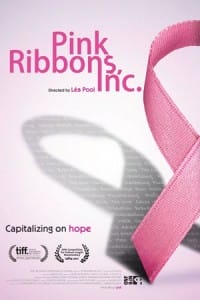Pink Ribbons, Inc


Canadian director Lea Pool, who’s best known for such fiction features as Set Me Free, takes a scattershot approach. In addition to the interviews, she includes animated sequences, vintage clips from news programs and public-service announcements, and coverage of pink-ribbon events: walks “for the cure” in D.C. and San Francisco, a pink-lighted Niagara Falls and Empire State Building, a jump by “Aerial Pink Force” skydivers.
Objections to such stunts are partially a matter of taste; although the movie devotes much of its attention to more substantive issues, it takes a few minutes to protest pink-ribbon kitsch and “the tyranny of cheerfulness.”
Pool and her two co-writers began with Samantha King’s book, Pink Ribbons, Inc.: Breast Cancer and the Politics of Philanthropy, and King is one of the movie’s main voices. Also featured are Nickled and Dimed author Barbara Ehrenreich, a breast cancer survivor; former surgeon Dr. Susan Love, a skeptic of “slash, burn and poison” treatments; and former Breast Cancer Action leader Barbara Brenner.
The principal witness for the defense is Nancy Brinker of Susan G. Komen for the Cure, who was interviewed before that group’s controversial (and quickly canceled) break with Planned Parenthood. Brinker’s group has channeled $1.9 billion to breast-cancer research. While that’s an extraordinary number, the results are less impressive: Some 59,000 people die of the affliction in the United States annually, and the number of cases has dramatically increased, here and worldwide.
The disconnect between research and results is one of Pink Ribbons, Inc.‘s keenest points. On-screen commentators contend that breast-cancer research is poorly coordinated and badly focused. Fewer than 30 percent of patients have a genetic proclivity for the illness, which indicates that most cases stem from environmental causes — yet relatively little attention is paid to prevention, or to chemicals that mimic estrogen and disrupt the human endocrine system.
OMTimes Magazine is one of the leading on-line content providers of positivity, wellness and personal empowerment. OMTimes Magazine - Co-Creating a More Conscious Reality








